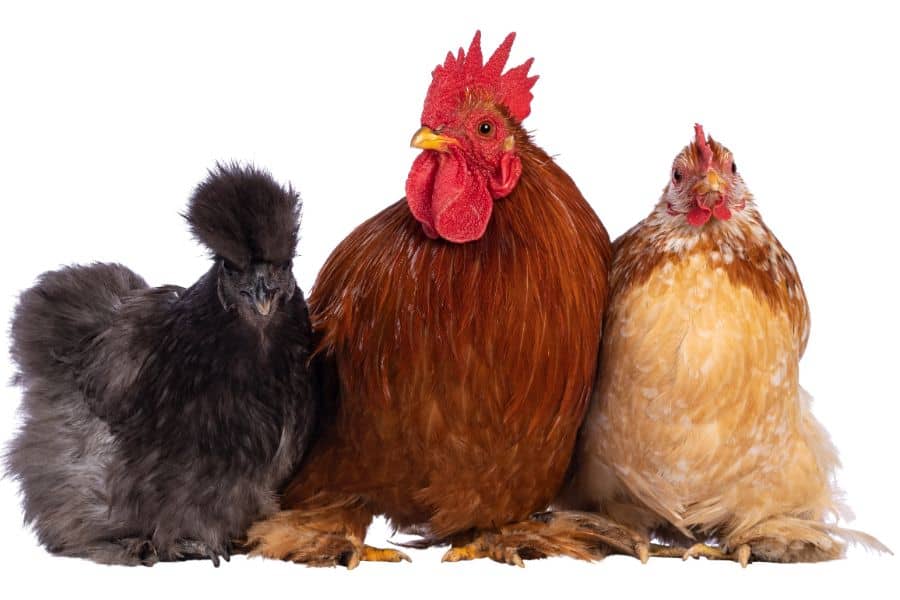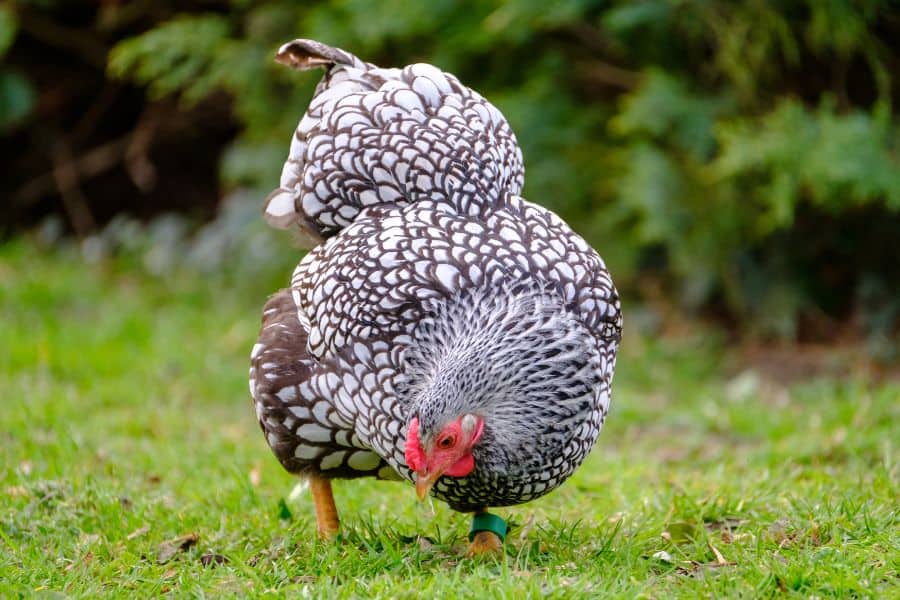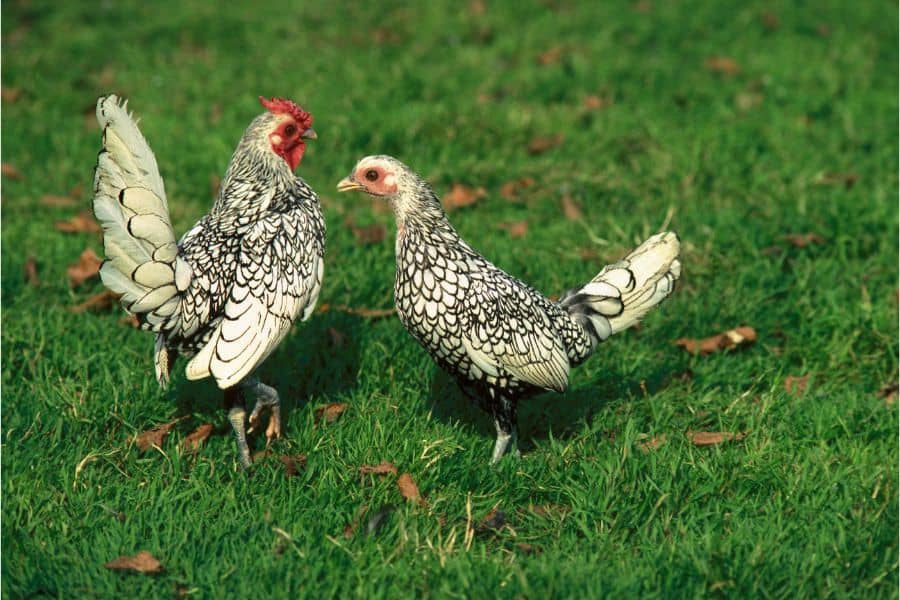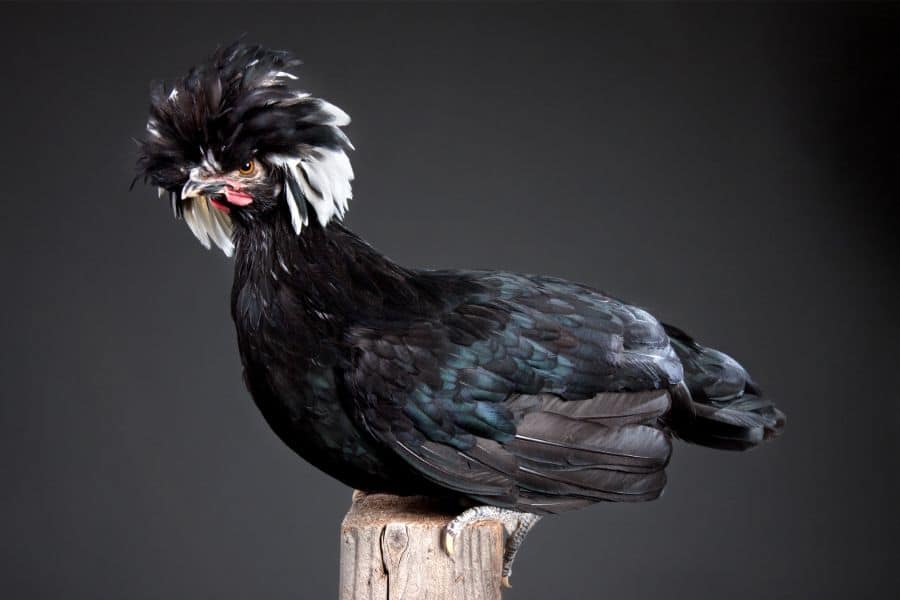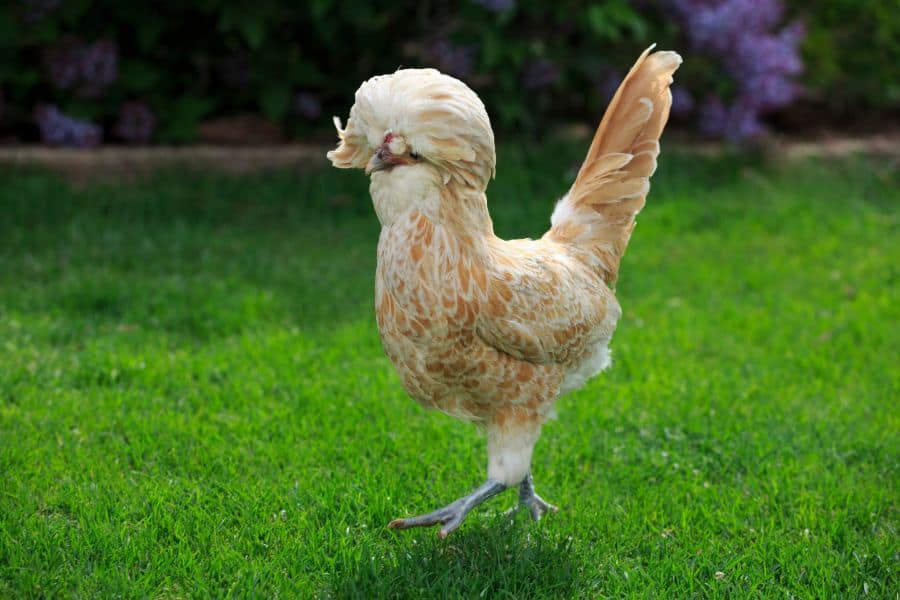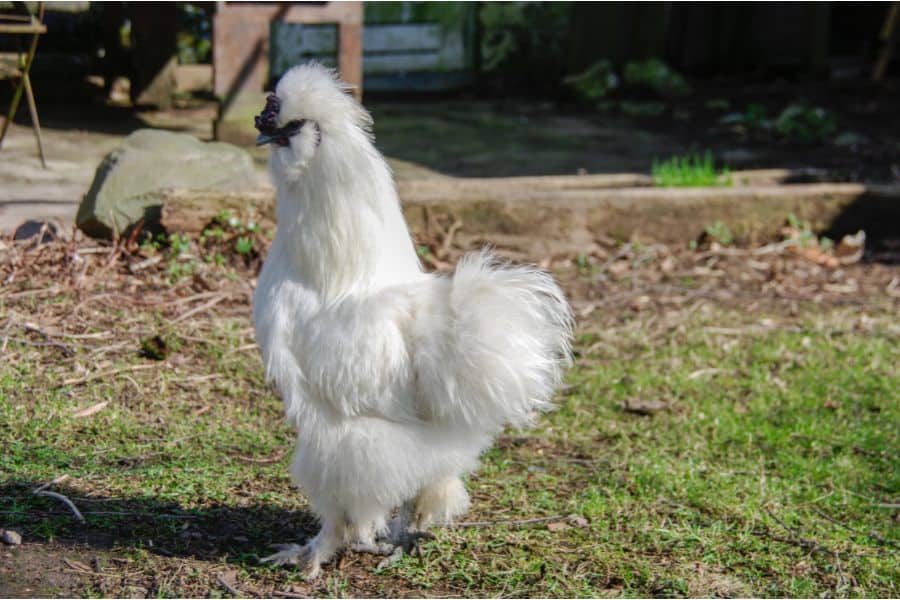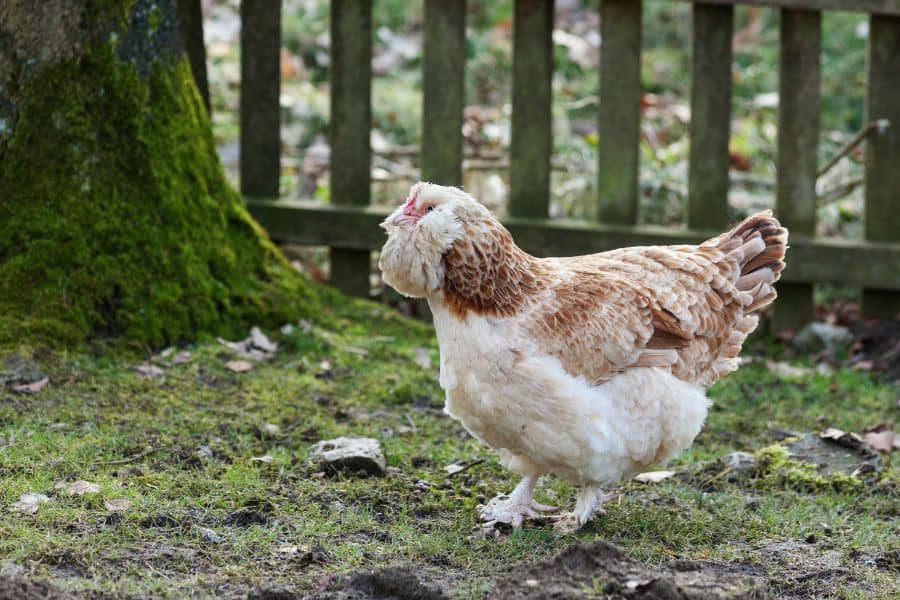Beauty may be in the eye of the beholder but there are some chicken breeds that will stand out in any flock.
Pretty chickens are not a passing fad. Many breeds exist today because breeders more than a century ago were trying to create birds that would be great for exhibition.
The spectrum of pretty chickens is wide. Some breeds may have many variants but with one or two that catch the eye more than others.
Some chickens stand out because of eye-catching plumage colors while others have unique feather patterns. In rare cases, it’s the chicken’s comb that actually defines its looks.
Chicken owners have been looking to add pretty chickens to their flocks for generations. If this is your thing, read on to discover some of the beautiful breeds you can get today.
14 Prettiest Chickens
1. Laced Wyandottes
There are more than 30 varieties of Wyandotte Chickens, but the Laced varieties might be the prettiest chickens ever developed.
The Silver Laced Wyandotte was the original Wyandotte Chicken. Its feathers have a base color of white with a black trim around the edge.
The Golden Laced Wyandotte is similar to the Silver except the white is replaced with gold. Buff Laced Wyandottes’ feathers are brown with buff lacing. They also have white tail feathers.
Blue Laced Wyandotte are recognized in Europe, and they might be the fanciest of the bunch. Their body feathers are brown with blue edges while their tail feathers are blue.
Wyandottes are not just pretty chickens, they are highly regarded dual-purpose birds. The hens can lay more than 200 large brown eggs per year and are heavy enough to be good table fowl.
- Origin: USA
- Primary Purpose: Meat, Eggs, and Exhibition
- Personality: Mild-Mannered
- Max Weight (Rooster): 9 lbs.
- Plumage Colors: White or Gold with black lacing
Also Read: Blue Laced Red Wyandotte
2. Modern Game
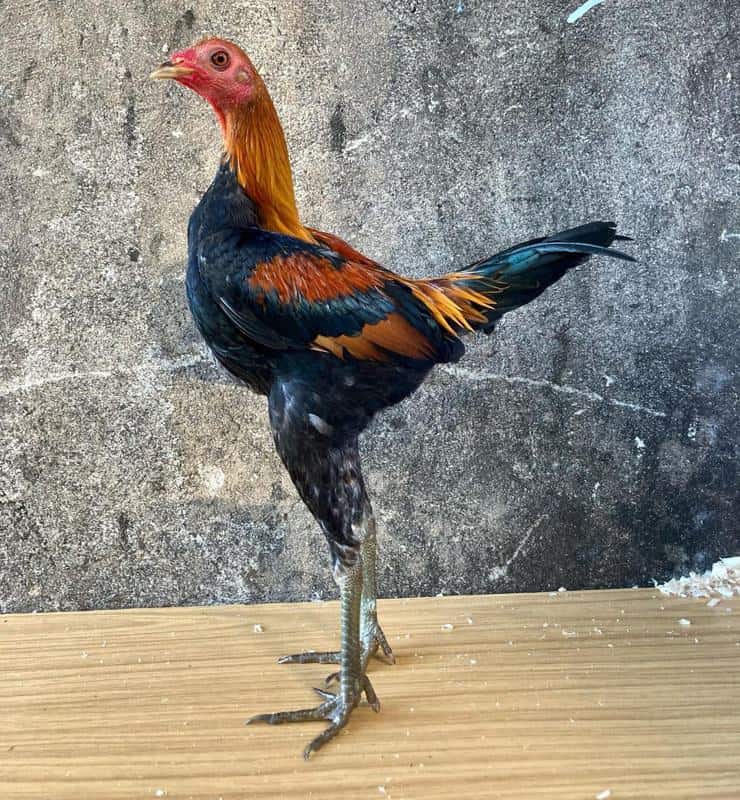
Modern Game chickens were bred to capture the aesthetic of the old fighting birds, but they were not actually bred to fight. They were the result of crossing Malays with Old English Game chickens.
These birds are quite tall, reaching heights of over 30 inches (0.76m). They come in a wide range of colors with the black red, brown red, Pyle, and birchen being among the most common.
For birds used in exhibitions, the combs and wattles will usually be removed. In addition to their aesthetics, Modern Game chickens are considered good pets for adults thanks to their curious and friendly nature.
Unfortunately, Modern Game chickens are poor layers with hens laying between 50 and 80 eggs in a whole year. These birds are also not typically raised for meat.
- Origin: England
- Primary Purpose: Exhibition and Pets
- Personality: Curious and friendly
- Max Weight (Rooster): 9 lbs.
- Plumage Colors: 12+
3. Sebright
The Sebright chicken is proof that pretty chickens come in all sizes. These birds are true bantams and the largest of them weigh around 620 grams or 1.4 pounds.
The Sebright was developed in the 1800s and its main plumage varieties are gold and silver.
The Gold Sebright has a dark gold base color with black lacing around the feathers’ edges. The Silver Sebright is similar but with a base color of whitish silver.
Sebrights have large breasts and wings that point downwards, contributing to their cool, angular, and confident look.
These chickens were developed to be an ornamental breed and that’s all they’re really good for. They are neither prolific layers nor big enough to make good table fowl.
- Origin: England
- Primary Purpose: Ornamental
- Personality: Curious and Active
- Max Weight (Rooster): 1.4 lbs.
- Plumage Colors: Black Laced: Gold, Silver, Lemon; White Laced: Buff
4. Millefleur Booted Bantam
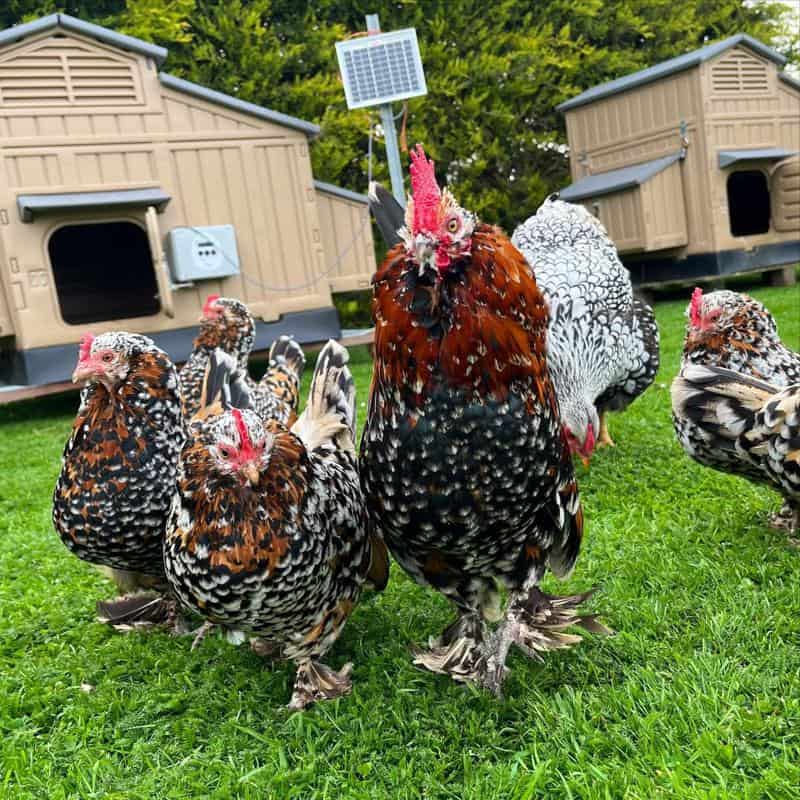
Booted Bantams are also true bantams although they are larger than Sebrights with roosters reaching weights of 1.87 pounds (850 grams). These chickens are noted for their heavily feathered legs and feet which gives them their characteristic booted look.
There are more than 30 color variants of this breed, but it is those with the millefleur plumage that can really stand out. These are the millefleur, gold millefleur, silver millefleur, and lemon millefleur.
The millefleur plumage is characterized by white-tipped black feathers that show up randomly all over the chicken’s body resulting in a speckled appearance.
Although they are typically associated with the Dutch, the development of these birds took place in the Netherlands, UK, Germany, and Belgium. As is usually the case with bantams, these birds are mainly kept for exhibition.
- Origin: Netherlands, Germany, UK, Belgium
- Primary Purpose: Ornamental
- Personality: Friendly, Docile
- Max Weight (Rooster): 1.87 lbs.
- Plumage Colors: Gold, Silver, Lemon, and brown; all with black and white speckles
5. Phoenix
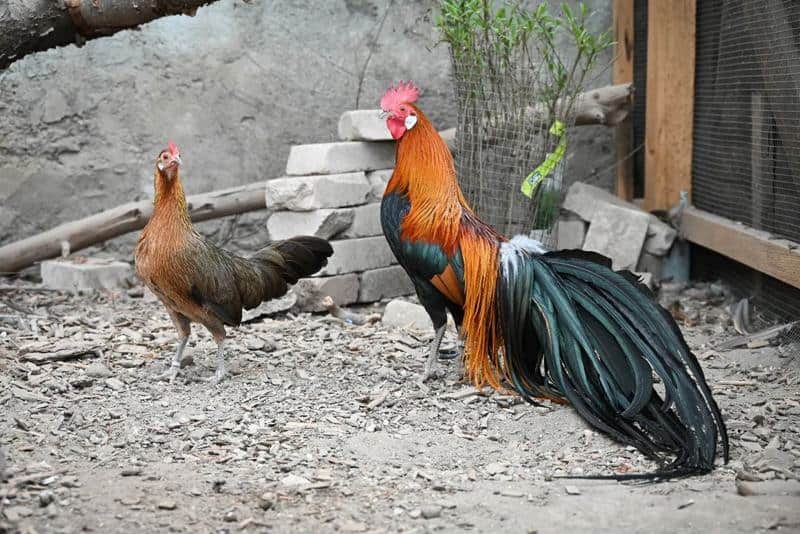
The Phoenix chicken’s call to fame is its long tail which can reach an impressive 5 feet in length. The long tails in Phoenix chickens are only present in males and they are the result of extra-long sickle feathers.
Phoenix chickens were created from the Japanese Onagadori chickens which can attain even longer tails than the Phoenix but don’t do as well in the colder European climate.
Phoenix chickens are of German origin and so far, the silver, gold, and black-breasted red are the color varieties recognized in the US. All birds are single-combed, and the combs and wattles are bright red while the earlobes are white.
Phoenix chickens aren’t great layers, topping out at around 126 eggs per year. This breed is mainly ornamental and requires a lot of care to keep its tail clean.
- Origin: Germany
- Primary Purpose: Ornamental
- Personality: Docile, Loners, Friendly
- Max Weight (Rooster): 5.5 lbs.
- Plumage Colors: Gold, Silver, Black-Breasted
6. Jubilee Orpington
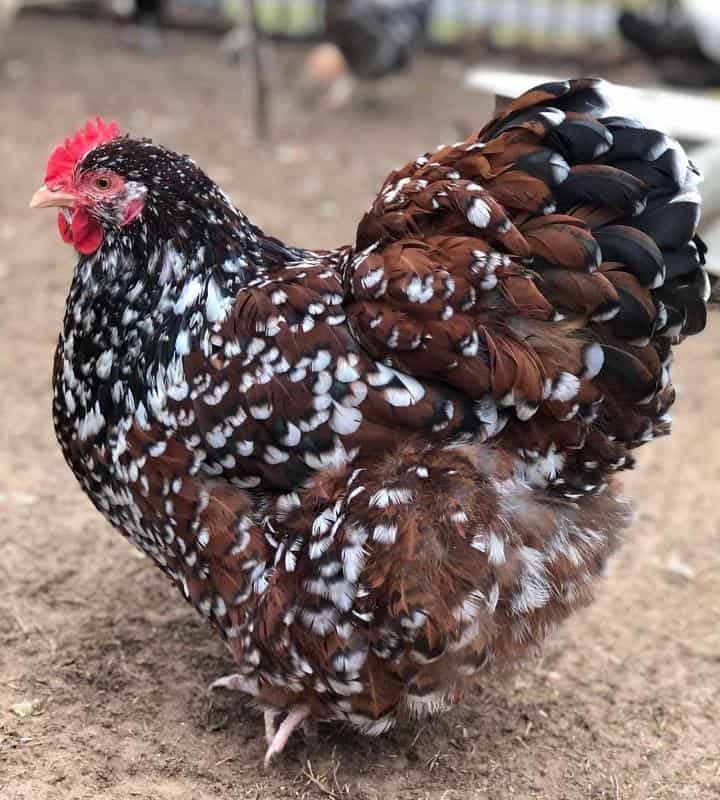
Jubilee Orpingtons were created to commemorate the 60th anniversary of Queen Victoria’s reign.
These birds have the fluffy look that all Orpington chickens share. Their plumage is a deep red or mahogany color with white and black speckles.
Despite their unique look, Jubilee Orpingtons only recently made it to North America, so they are still a rare sight.
Jubilee Orpingtons are calm birds that should be a delight to have around kids as they are easy to pet. Their size makes them less likely to fly, hence easier to contain.
Orpington chickens always make good dual-purpose chickens with carcasses that yield plenty of meat and hens that can lay over 200 eggs in a year.
- Origin: Orpington, England
- Primary Purpose: Eggs, Meat, Exhibition
- Personality: Friendly, Calm
- Max Weight (Rooster): 10 lbs.
- Plumage Colors: Mahogany with black and white speckles
7. Double-Laced Barnevelder
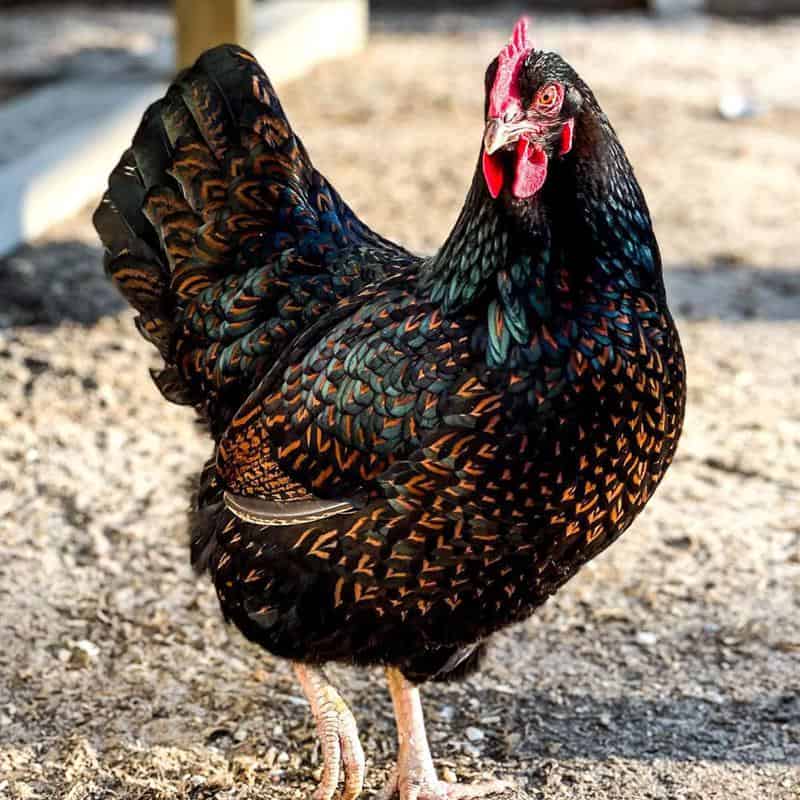
Barnevelder chickens’ path to recognition as a breed was not straightforward. They were initially not recognized due to a lack of consistency in their plumage colors.
Eventually, this breed would provide some of the most beautiful double-laced chickens ever seen.
The color of Double-Laced Barnevelders’ feathers is a deep brown with black double lacing. Their heads are black with a green iridescence.
As beautiful as they are, the main appeal of Barnevelders is their ability to lay up to 200 brown eggs in a year. Their production is consistent even through winter.
Barnevelders were developed in the Netherlands from 1865 but weren’t recognized as a breed until 1923. They get along well with people and other chicken breeds in mixed flocks.
- Origin: Netherlands
- Primary Purpose: Eggs
- Personality: Friendly and Calm
- Max Weight (Rooster): 7.7 lbs.
- Plumage Colors: Brown with black double lacing
8. Polish
Polish chickens have many unique features but none of them stand out like their crests. The crests on these birds can grow so large that it hides their combs and obscures their vision.
Polish chickens’ crests create certain practical challenges and have resulted in these birds being easily startled. However, when approached gently, they are a calm and friendly breed.
Ten color variants of this breed are recognized by the American Poultry Association. Some Polish chickens are bearded, and others have frizzled feathers.
These birds are favored for their white medium-to-large eggs, and they can produce as many as 150 in a year.
Cold weather doesn’t suit Polish chickens due to the risk of their crests becoming waterlogged and cold or frozen.
- Origin: Unknown
- Primary Purpose: Eggs
- Personality: Friendly but Easily Startled
- Max Weight (Rooster): 6 lbs.
- Plumage Colors: 10
9. Silkie
Silkies are one of the breeds that have come to define ornamental chickens. They are popular with many backyard chicken keepers who keep them as pets or to hatch and raise the eggs of other birds.
The defining characteristic of this breed is its unique plumage which has the texture of silk and a puffy appearance. However, these chickens get even more interesting because they have crests and, like the Ayam Cemani, have black bones and skin.
There are eight recognized colors of the Silkie breed including black, white, buff, and blue, but more colors are also in development including millefleur. They have walnut-shaped combs and blue earlobes.
In some countries, Silkies are considered a bantam breed since their roosters weigh only about 3 pounds and the hens are even lighter at 2 pounds. Silkies can either be bearded or non-bearded.
- Origin: China
- Primary Purpose: Ornamental
- Personality: Friendly and calm
- Max Weight (Rooster): 3 lbs.
- Plumage Colors: Eight
10. Yokohama
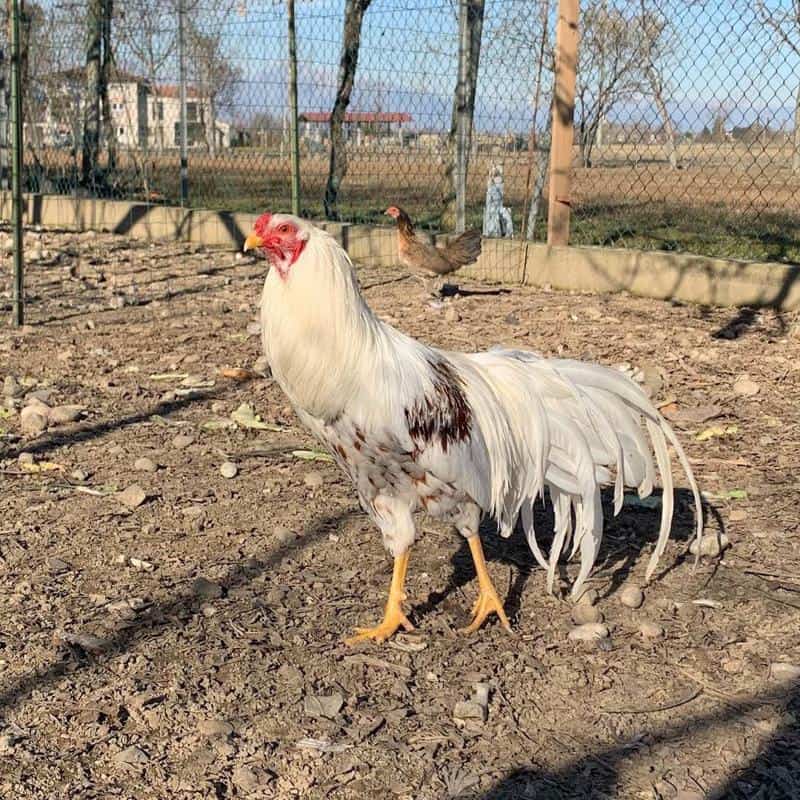
Yokohama may sound like an unusual name for a German chicken breed but that’s because they were derived from long-tailed chickens from Japan.
Yokohama chickens are relatively small chickens but have impressive tails that can be as long as three or four feet. The two recognized plumage varieties today are the White Yokohama and the Red-Shouldered or Red-Saddled Yokohama.
The heaviest Yokohama chickens weigh about 5.5 pounds. These birds are primarily kept for exhibition as they are not good layers, producing roughly 80 eggs in a year.
Yokohama chickens do well in warm environments, and they are easy to handle and tame. Although they don’t mind confinement, they are better suited to a large space where they can easily roam, dragging their long tail feathers on the grass.
- Origin: Germany
- Primary Purpose: Ornamental
- Personality: Friendly and alert
- Max Weight (Rooster): 5.5 lbs.
- Plumage Colors: White and Red-Shouldered
11. Millefleur d’Uccle
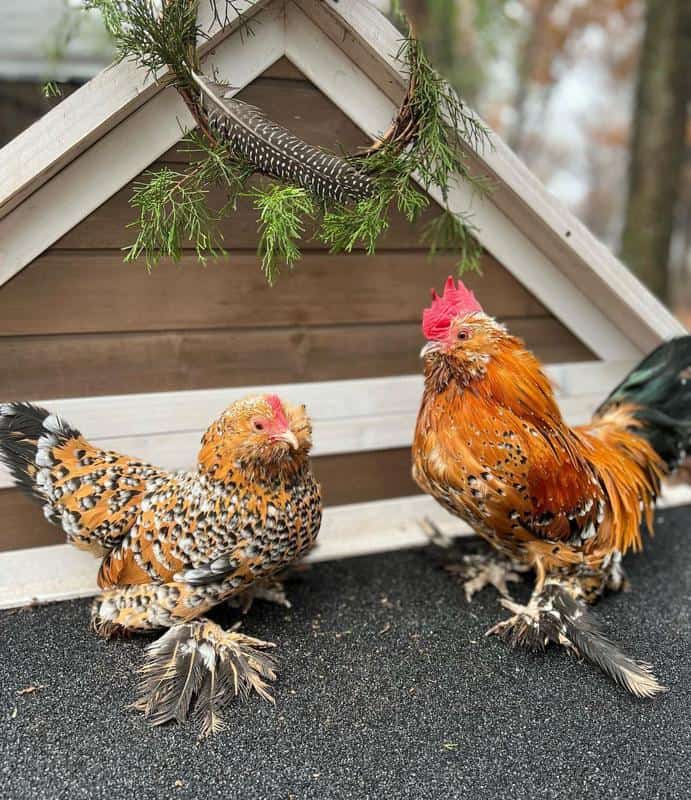
This chicken from Belgium is a true bantam that was first shown to the public in 1905. In its native Belgium, there are 28 recognized color varieties of the Barbu d’Uccle breed, but the Millefleur d’Uccle has been an important ambassador for the rest of the breed.
The Millefleur d’Uccle was one of the first two color varieties of the Barbu d’Uccle. It is believed that Barbu d’Anvers chickens were crossed with the Sabelpoot to create this breed.
These chickens have muffs and beards plus heavily feathered legs. They also have single combs. The Millefleur d’Uccle has white and black speckles on its plumage for that extra-special effect.
The wide tails of these birds are held at high angles. Their wattles can be so small they almost seem completely absent.
It takes around two years for the colors of these birds to reach their full potential.
- Origin: Belgium
- Primary Purpose: Ornamental
- Personality: Friendly, docile, chatty
- Max Weight (Rooster): 1.65 lbs.
- Plumage Colors: Brown with black and white speckles
12. Sultan
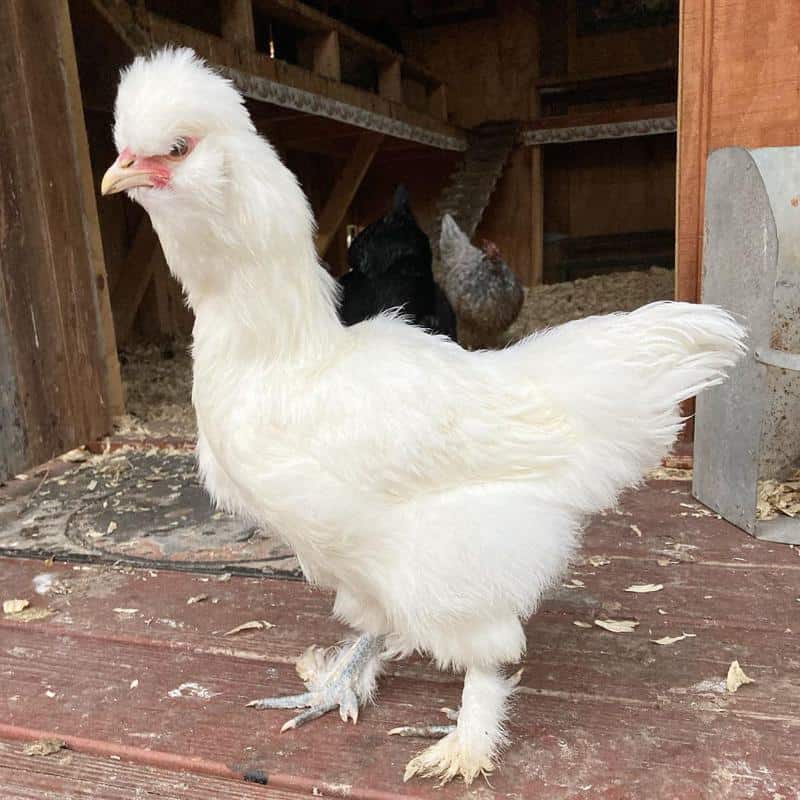
Sultan chickens have a lot stacked against them, but these pretty birds have fans so dedicated that they’ve ensured this bird never died out, even though it came close. These birds once graced the gardens of Sultans of the Ottoman Empire.
Sultan Chickens have many unique features but the luxurious-looking feathering along with their puffy crests are the hardest to miss. Although only the White Sultan Chicken is officially recognized, you can also get them in blue or black.
Sultan chickens need lots of care compared to your regular chicken. Their crests can leave them vulnerable to predators and they easily get frostbite in very cold climates.
These birds are mostly ornamental since they only manage around 50 eggs in a year. The roosters can reach about 6 pounds in weight.
- Origin: Turkey
- Primary Purpose: Ornamental
- Personality: Friendly and chatty
- Max Weight (Rooster): 6 lbs.
- Plumage Colors: White, black, blue
13. Faverolles
Faverolles are large chickens that can weigh as much as 11 pounds. But these birds are not just big, they are also beautiful.
Faverolles have muffs and beards and the main plumage color of these birds today is Salmon. Salmon Faverolles are a mix of brown and white with roosters having darker browns and straw-colored feathers, in addition to black feathers.
Salmon Faverolles are the only chicken breed with the Salmon color today.
The feet of Faverolles have feathers and five toes which is unusual for chickens.
These birds were once prized layers but are mainly kept for ornamental purposes today. They can lay more than 200 eggs in a year and are also delicious meat birds.
These chickens are curious and active. They make good family chickens because they interact well with children.
- Origin: France
- Primary Purpose: Eggs, Meat, Ornamental
- Personality: Active, Curious, Friendly, and Alert
- Max Weight (Rooster): 11 lbs.
- Plumage Colors: 8
14. Black Rosecomb Bantams
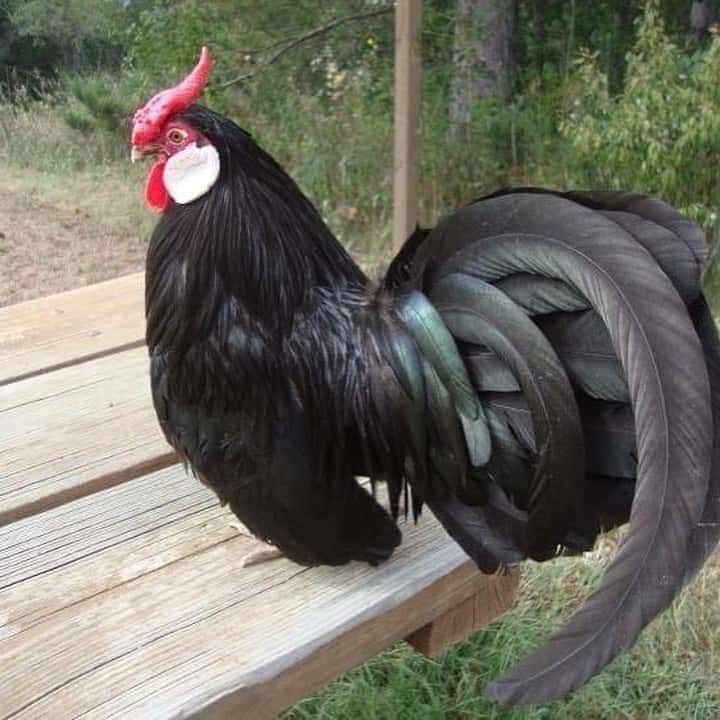
Rosecombs are yet another true bantam and one of the oldest in this list with a history going back to the 14th century. These chickens were even raised by King Richard the Third in the 15th century.
There are 25 plumage options for this breed, but the Black Rosecomb Bantam stands out thanks to the rich black color of its plumage with its green sheen.
The comb of this breed is a key feature. It is large, beaded, and extends backward. It has a cherry-red color that really stands out against the black plumage of this variant.
Beautiful as they are, these birds have been selectively bred for aesthetics for a long time. As a result, their meat is generally not suitable for eating, the hens are subpar layers, and some roosters have low fertility rates.
- Origin: United Kingdom
- Primary Purpose: Ornamental
- Personality: Lively
- Max Weight (Rooster): 1.4 lbs.
- Plumage Colors: Black
Read More:
Final Words
Practical farmers might be surprised that beauty is the first thing some people look for in a chicken. However, some chicken breeds only exist today because people consider them pretty.
Pretty chickens come in many shapes, sizes, and varieties. Birds like the Sultan and Sebright are dainty but the Jubilee Orpington and Faverolles are some of the largest chickens out here.
Many of these pretty chickens are very practical and are capable of producing more than 200 eggs for you in just a year. Others also make excellent table fowl.
On the other hand, some of these pretty birds are only seen as delicate ornaments that require careful handling. Those with long tails and feathered legs can be especially tricky.
There is something for everybody looking for pretty chickens. Maybe today is a good day to add one to your flock.
